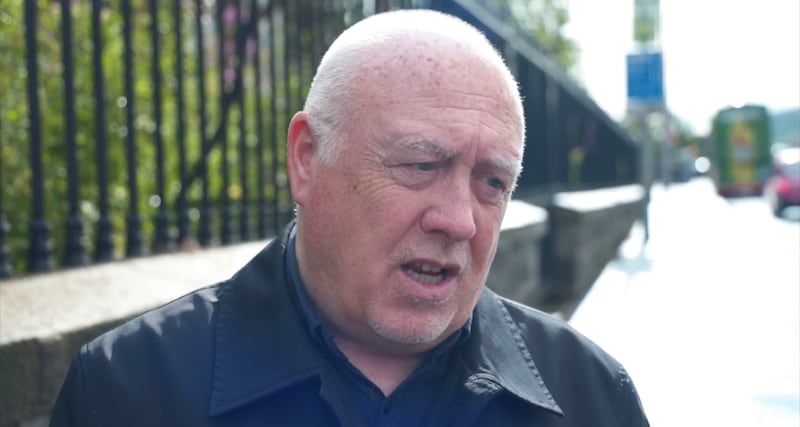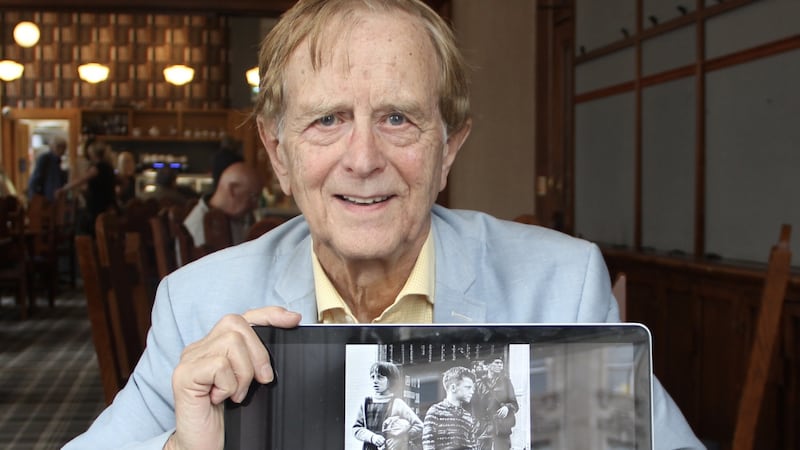Malachi O’Doherty
- Author, journalist and broadcaster
I was 18 in August 1969. It was the summer holidays. My brother was out on the street campaigning for reform of the local government franchise and I was trying to get laid.
It was a time when rock music, dancing and girls was all becoming available in the pattern that was happening across all of Europe. There was a social and cultural revolution happening anyway because we were the generation that came after the Second World War.
We saw a gradual increase in violence the previous year and that had the potential to spread. We didn’t anticipate how calamitous it would be.
I think Belfast was traumatised by those days. Had those days not been so shocking, a level of rioting might have continued without it turning into a major terrorism campaign.
It pitched to a new level on August 14th in Divis Street. Imagine a British police force deploying machine guns in a British city.
There was a major riot going on near Divis flats. The police used Whippet armoured cars to break up the crowd and they moved into the Divis flats complex. It was shots from those armoured cars that killed young Patrick Rooney and Hugh McCabe.
The RUC lost the run of themselves. They were confused by the sound of their own guns. You had a three corner battle on the Falls Road between the Republican rioters and their supporters, loyalists from the Shankill Road and the police with guns.
The guys on the top of the Divis flats had crates of petrol bombs. They didn’t light them. They dropped a crate of bottles to create a pool of petrol and as the police approached they would try to incinerate them.
It was pretty daft to say that this was a pogram against the Catholic people and they needed the defence. That was the easy reading of it at the time. The IRA coaxed the RUC into a riot in the Bogside and they carried it to Belfast.
They did organise a major riot on the Falls Road. They didn’t have to do it, but they had a plan to break the RUC.
My father Barney O'Doherty managed two bars at the top of Agnes Street and the Crumlin Road, the Enfield Arms and the Cliftonville Hotel.
On August 15th after the night of the shooting, my sister and I walked up to Agnes Street to see how my brother was getting on looking after the bars as my mother and father were on holidays.
The clientele was almost all Protestant though the bars were owned by Catholics and staffed by Catholics.
The whole atmosphere in the bar had changed. People who would normally say hello to you and be civil stopped being civil. That made it all quite uneasy.
My brother took the decision to close the bar. The bars were burnt out presumably by loyalists.
I remember a friend of mine, Brendan, saying to me, “Malachi, this is going to last 20 years”.
There will always be sectarian conflict in Northern Ireland but it didn't need to escalate to the scale it escalated to in August 1969.

Danny Morrison
- former Sinn Féin publicity director
On Thursday, August 14th 1969 the Civil Rights Association called for people to come out in nationalist areas and block the roads.
The RUC had beaten to death Sammy Devanney in Derry and a civil rights man in Dungiven (Francie McCloskey) was killed.
Our whole purpose was to keep the police here because the police in Derry were completely exhausted and the government was going to send reinforcements in.
The help we were given by the Travelling community was incredible because they had lorries
I was 16 at the time. I went home at 10.30pm on the night of the 14th. I could hear the shooting starting. I never heard anything like it before.
It was terrifying. On the Friday morning (August 15th) my friends and I came back down the road again and we helped people to move their furniture. The help we were given by the Travelling community was incredible because they had lorries. They risked their lives because there were still snipers about.
The RUC and the B Specials had all come down the streets opposite Divis Flats and for the next mile all of that street up until the Falls library was burnt down. Thousands of people were burnt out of their homes.
An armed struggle, a united Ireland was fantasy to us then and it was only as things deteriorated that the conflict broke out.
Initially we welcomed the British army. We took it that they were there to genuinely protect us. Our priority was to stop our homes from being burnt down and if the British army was going to save us we would welcome them, but as it turned out they weren’t there to save us.
Nine months later the British army surrounded this area again (the Falls Road curfew) and gassed it from the air. They shot dead five people during the curfew against people who had never fired against the British army before. That was the turning point when a large section of people realised the British army weren’t there to protect them. They were there to protect the status quo.
In 1972 when Stormont was prorogued after Bloody Sunday and the British government engaged with the IRA, we thought that was going to be the end of it. It went on because people refused to talk.
Of all those early killings, nobody was arrested and nobody was charged. Twenty-four civilians were killed before the IRA fired the first shot, but as far as the historians and the media are concerned, the IRA started it all which is a nonsense.

Stanley Matchett
- A photographer with The Daily Mirror newspaper in 1969, Matchett later went freelance and is the photographer who took the famous photograph of Bishop Edward Daly with one of the victims of Bloody Sunday
To the shock of most of the people of Belfast, the trouble came our way in August 1969. I lost count of the number of times we were up and down to Derry the previous year.
Running up to 1969, Belfast had a very quiet time in comparison with Derry. All hell was breaking loose there with the civil rights parades and war cannon, but in Belfast it seemed to be normal.
The dance halls were full and the cinemas were busy, but as the Troubles went on, the city lost all of its night entertainment.
The atmosphere when the army came on to the street in Belfast was awful
The Crumlin Road in August became a flash point because the army were brought on to the street after the shooting.
It’s near the Shankill Road which was predominantly Protestant and then you have the Falls Road which is Catholic so it was an interface. There was no peace line then. That came later.
I was on the opposite side of the street to the violence and I spotted these two kids with a soldier behind them. I had a long lens so they weren’t aware they were being photographed.
The whole photo had the ambience of something taken in the 50s, the way the soldier were dressed.
There was an exhibition in 2007 with 65 photographers from the Troubles exhibiting. Michael Longley, one of our best loved poets, said my picture tells the whole story of the Troubles in one photograph. It was a very strong image.
The atmosphere when the army came on to the street in Belfast was awful. People did not know what was coming next.
At one stage the population were living fairly normally and then everything was street searching and the people were not talking to each other.
Not in a million years did I think there would be 25 years of Troubles. Every time there was a big bomb explosion, you thought this would end it and you didn’t feel like it couldn’t get any worse and it did.














